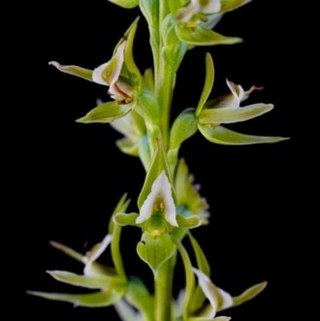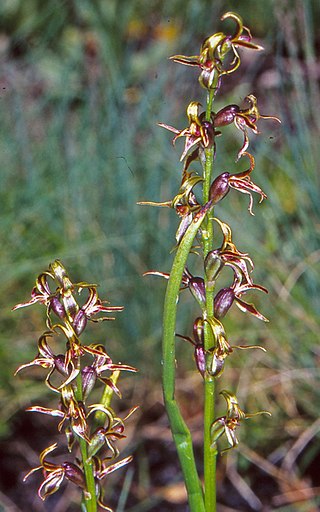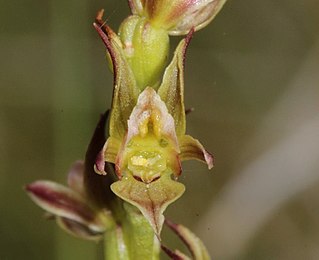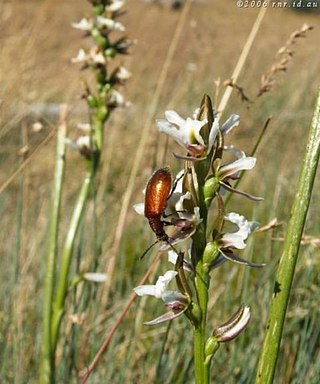
Prasophyllum alpinum, commonly known as the alpine leek orchid, is a species of orchid endemic to Tasmania. It was formerly described as occurring in mainland Australia but has smaller flowers than the species occurring there. It has a single, tube-shaped leaf and up to fourteen green to greenish-brown flowers and grows in subalpine areas.
Prasophyllum australe, commonly known as the southern leek orchid or austral leek orchid, is a species of orchid and is endemic to south-eastern Australia. It has a single tubular, green leaf and up to fifty scented, greenish-brown flowers with red stripes.
Prasophyllum anticum, commonly known as the Pretty Hill leek orchid, is a species of orchid endemic to Victoria. It has a single tubular, dark green leaf and between ten and twenty five scented, greenish-brown flowers and is only known from a small area in the south-west of the state.

Prasophyllum brevilabre, commonly known as the short-lip leek orchid, is a species of orchid endemic to south-eastern Australia. It has a single tubular, green leaf and up to thirty small, greenish-brown flowers with a white labellum. The labellum is sharply turned back on itself so that its tip almost reaches its base.

Prasophyllum montanum, commonly known as the mountain leek orchid, is a species of orchid endemic to eastern Australia. It has a single tubular, green leaf and up to fifty scented, greenish to pinkish flowers. It grows in montane ecosystems at altitudes above 1,500 m (5,000 ft).

Prasophyllum sphacelatum, commonly known as the subalpine leek orchid, is a species of orchid endemic to south-eastern Australia. It has a single tubular, dull green leaf and up to eighteen scented, green to brownish flowers with a green to pinkish labellum. It grows in subalpine areas of New South Wales, Victoria and Tasmania.

Prasophyllum odoratum, commonly known as the fragrant leek orchid, Rogers scented leek orchid or sweet leek orchid is a species of orchid endemic to south-eastern Australia. It has a single tubular leaf and up to fifty fragrant green and white flowers with reddish marks.

Prasophyllum lindleyanum, commonly known as the green leek orchid, is a species of orchid endemic to south-eastern Australia. It has a single smooth, tube-shaped leaf and up to twenty scented, greenish flowers with a greenish or white labellum with a pink tinge.
Prasophyllum candidum, commonly known as the Kiandra leek orchid, is a species of orchid endemic to eastern Australia. It has a single tubular, yellowish-green leaf and up to forty scented, bright white to greenish flowers. It grows in subalpine areas at altitudes above 1,000 m (3,000 ft) in New South Wales and Victoria although in the latter state it is considered to be a form of P. odoratum.

Prasophyllum frenchii, commonly known as the maroon leek orchid or swamp leek orchid, is a species of orchid endemic to south-eastern continental Australia. It has a single tubular green leaf and up to sixty five green, reddish-brown or red flowers. Formerly more widespread, it is now confined to seven populations containing a total of fewer than 1,000 plants.
Prasophyllum niphopedium, commonly known as the marsh leek orchid, is a species of orchid endemic to a small area in Victoria. It has a single tubular leaf and up to twenty greenish flowers with reddish markings. It is only known from five population on grassy alpine plains with the total number of individual plants less than five hundred.
Prasophyllum parviflorum, commonly known as the slender leek orchid, is a species of orchid endemic to eastern Victoria. It has a single tubular leaf and up to thirty greenish-brown to purplish flowers. Further studies of the species may indicate that some collections currently included may be of a different species.

Prasophyllum patens, commonly known as the broad-lipped leek orchid or sandstone leek orchid, is a species of orchid endemic to the Sydney region of New South Wales. It has a single tubular green leaf and up to thirty green to greenish-brown, lemon-scented flowers with a white labellum.
Prasophyllum regium, commonly known as the king leek orchid, is a species of orchid endemic to the south-west of Western Australia. It has a single, unusually thick tubular leaf and up to one hundred relatively large, greenish-brown or burgundy-coloured flowers. It is one of the tallest leek orchids, sometimes growing to a height of 2 m (7 ft).
Prasophyllum rogersii, commonly known as the Barrington Tops leek orchid is a species of orchid endemic to New South Wales. It has a single tubular leaf and up to twenty five reddish-brown flowers and only occurs in a few locations at higher altitudes.

Prasophyllum suttonii, commonly known as the mauve leek orchid, Mount Buffalo leek orchid or Buffalo leek-orchid, is a species of orchid endemic to the Australian Alps. Some authorities list the species as being a Victorian endemic now extinct whilst others list is as occurring in New South Wales and extant. Descriptions of the species also differ. It has a single tube-shaped leaf and up to thirty five white flowers with purple or mauve marks.
Prasophyllum fitzgeraldii, commonly known as FitzGerald's leek orchid, is a species of orchid endemic to South Australia. It has a single tube-shaped leaf and up to thirty five green or reddish-brown flowers with a pink to purple labellum. It was previously thought to also occur in Victoria.
Prasophyllum constrictum, commonly known as the tawny leek orchid, is a species of orchid endemic to South Australia. It has a single tubular leaf and up to thirty five scented, brown or reddish-brown flowers with a pink or purplish labellum. Richard Sanders Rogers, who named this species, described the flowers as "prune-coloured".
Prasophyllum occidentale, commonly known as the plains leek orchid, is a species of orchid endemic to southern continental Australia. It has a single tubular leaf and up to twenty five small, pale yellowish-green flowers. It is found in South Australia and Victoria although regarded by some taxonomists as a South Australian endemic.
Prasophyllum pilligaense is a species of orchid endemic to New South Wales. It has a single tubular, shiny dark green leaf and up to thirty scented greenish brown to brownish and white flowers. It is only known from a few populations in the Coonabarabran district.









